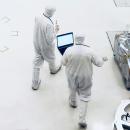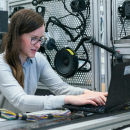
Vitality, a territorial ecosystem to improve Italy’s central regions
A real "ecosystem" for innovation, digitalization and sustainability, serving research as well as the economy of Italy's central regions. This is Vitality, a journey that started in 2023 and that will have its epilogue at the end of 2025. The partnership is made up of as many as 24 bodies, including 10 universities, 4 public entities and 10 private ones.
This is an ambitious project, one of 11 "territorial ecosystems" funded by the Ministry of Universities and Research (Mur), as part of the National Plan for Recovery and Resilience (NRPR). We are dealing with nearly 115 million euros that will be used for the purpose of strengthening the cooperation of important subjects and entities of three neighboring Italian regions: Abruzzo, Marche and Umbria.
It is no coincidence, in fact, that the universities of L'Aquila (which is also the proponent of the entire ecosystem), Chieti-Pescara, Teramo, and Gran Sasso Science Institute for Abruzzo, Perugia for Umbria, the Polytechnic University of the Marche, Urbino, Camerino and Macerata for the Marche, as well as the University of Molise, have already been working on this for some time.
Alongside the universities, there are other major public entities involved, such as the National Research Council, the National Institute of Astrophysics, the Teramo Zooprophylactic Institute, and the National Institute for Rest and Care for the Elderly, as well as several other private players which are important to the economy of our country.
Two phases for connected territories
The involved organizations operate in various ways and in different territories, but at the same time are united by common socio-economic, historical and even morphological characteristics. In fact, there are the Apennine areas but also the Adriatic coast, in each case non-metropolitan urban areas whose life historically stems from the symbiotic relationship between university, city and business. This is the case for Perugia as well as for L'Aquila, not to mention Camerino and Urbino (long called "the campus city of Italy"). The same goes for decentralized universities in their respective territories, such as the Polytechnic University of Marche and the University of Molise. In these regions, the productive fabric is substantially composed of small and medium-sized enterprises, although not in toto. In fact, there are also several large corporations, some of which are part of Vitality.
The overall objectives of the whole operation can be divided into two major phases. On the one hand, research oriented toward the innovative development of the area. In this sense, we are concerned with many areas, from digital technologies to engineering, psychosocial and medical sciences, from biotechnology to physics to, of course, the aerospace sector in which the Astra project is immersed. Then there are all the aspects related to the transmission of the research results, at the service of productive areas, always within the fields of action, and always guided by the three key concepts - innovation, digitalization and sustainability.
But what is the project about concretely? It is made up of ten "spokes," that is, the 10 macro-projects of which the Vitality ecosystem is composed. Four of these are coordinated by universities in the Marche region, two by the University of Perugia (the only Umbrian university) and four by universities in Abruzzo. These latter include the Gran Sasso Science Institute (Gssi), lead partner of Astra, the spoke 2 of Vitality.
Astra: a research alliance
Astra stands for Advanced Space Technologies and Research Alliance. In addition to the Gssi that leads it, the project can count on the affiliation of the University of Perugia and the National Institute of Astrophysics (Inaf). The private companies that are part of it are the Bruno Kessler Foundation and Thales Alenia Space SpA.
The Gssi is the most recently established and most internationalized university in the entire ecosystem: in fact, more than 40 percent of its students come from abroad. It is a postgraduate school, which offers doctoral programmes in various disciplines and is the only postgraduate university in the national university system that is located in southern Italy.
The University of Perugia, an Astra-affiliated university, is one of the oldest and most prestigious in the country and also the only one to coordinate two spokes in Vitality (9 and 10). Inaf is a research organization established in the late 1990s that brings together astronomical observatories distributed throughout Italy. In short, it deals with the study of the Universe, in close synergy with other entities in the field, such as the National Institute of Nuclear Physics (Infn).
Alongside these public entities, as mentioned, two private entities also participate in Astra. One is the Bruno Kessler Foundation, which has its base camp in Trento and is involved in scientific and technological research (with a focus on cybersecurity and artificial intelligence). The second is Thales Alenia Space SpA, an Italian-French multinational company in the space sector, specialized in the production of satellites, probes and observatories, and which has one of its plants in L'Aquila, one of the territories involved in the ecosystem and indeed the one where the University proponent of the entire Vitality ecosystem was born.
Astra's main goal is to develop technologies and devices that can help bridge the gap between "pure" research and research destined to the industrial and commercial spheres, of course in the space sector. Specifically, the research activities will cover both hardware (from space technologies to X-ray observation) and software (such as digital satellite twins or on-board software platforms), with a focus on technology transfer and the impact of the project on the territory and in the productive fabric.
These three angles (hardware, software and impact) also represent the three work packages that make up the project. In the next articles we will recount this latter, with the aim of narrating the relevance, design and results of Astra.



